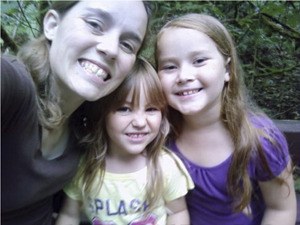Becky Harrington was diagnosed with cystic fibrosis in 1982, when she was three months old. Not even old enough to eat solid food, her parents were forced to administer 60 pills a day so their daughter could digest a meal.
The genetic disorder, simply put, causes the unending production of mucus. The onslaught causes deadly health problems as the body tries and fails to eliminate the excess.
“Everybody’s different” in their symptoms, Harrington said. “I wasn’t supposed to be able to have kids—I have two now—breathing becomes difficult, and you can get an enlarged liver, which was the cause of my digestive problems as a baby.
“Some people with this disease have way more digestive problems, but I was on a feeding tube for four years. Toward the end, I actually got sick of it; I preferred not eating to being connected to the tube all the time.”
Life expectancy for children with cystic fibrosis hovered around six-years-old at the time of Harrington’s birth, but in an odd way she was lucky. Medical treatments advanced over the course of her lifetime. By the time she was six-years-old, life expectancy had reached 12-years-old; at 12, it was 18, with some patients making it to age 30. Medication became more efficient: the number of pills required to treat her pancreas, for example, was whittled down from 20 to four.
“For most people there’s this hump around age 20,” she said. “You either die from complications, or you make it over the hump and live to 30. I made it over the hump. I became pregnant with my first daughter at 20, and that actually helped my lungs become stronger and get through the window.
“They’ve written a paper about it since then. It’s interesting how that works.”
Nevertheless, Harrington’s health continued to decline over the next decade. She was prescribed an oxygen tank and placed on the waiting list for a lung transplant in 2006. She wrote in a recent open letter to family and friends that she was worried for her daughters Hannah and Bethany. How much longer would she be around for them?
By age 30, Harrington had spent an average of two two-week stays in the hospital per year for what had become a routine “clean-out”: she would be hooked up to IV antibiotics to combat infections from fluid buildup in her body. It wasn’t unusual. So it seemed routine when she was admitted to the hospital in 2010 for shortness of breath. But she would find out her health had hit a new low.
“By the time I was closing in on 30, I had 17 percent lung capacity,” she said. “There was more scarring; the rest of my lungs were pretty much scar tissue. Airways were closed off.”
The situation was bleak by the time she was readmitted in 2011—bleak enough to warrant a call to her mother “just in case,” she said. She didn’t know it at the time, but her doctors estimated she had five days left.
But Harrington wouldn’t die. Instead, she was blessed with a deus ex machina: she was a match for a set of lungs that had become available via Susan, a donor from Montana.
As soon as the organ came in, University of Washington surgeons performed the transplant. Harrington’s internal scarring made removal difficult, but the surgery was ultimately a success.
The turnaround in Harrington’s health was immediate. She was off her oxygen tank after a day. Suddenly, she could do anything she wanted, things she couldn’t think about doing before.
“I have letters from my kids to the donor family,” she said. “And they wrote about all these little things. I can read to them without coughing. I can play with them. I can snore at night. Just these little things I might not think about otherwise, but mean a lot to them.”
Now she spends all her spare time volunteering, whether teaching art or participating in PTA.
And she’s reinitiated her participation in the Cystic Fibrosis Foundation, a nonprofit organization that raises funds for disease research. This Saturday, she will walk with team Breathe Easier in Roegner Park for the annual Great Strides fundraiser. They join more than 200 participants and 25 teams in the Roegner walk alone; last year the walk netted $70,000, according to Alison Morton, a director of development for CFF’s Washington/Alaska chapter.
Harrington has already achieved 90 percent of her $1,200 goal, and expects to surpass that goal by the time of the walk.
Her donation page is cff.org/Great_Strides/BeckyHarrington.



